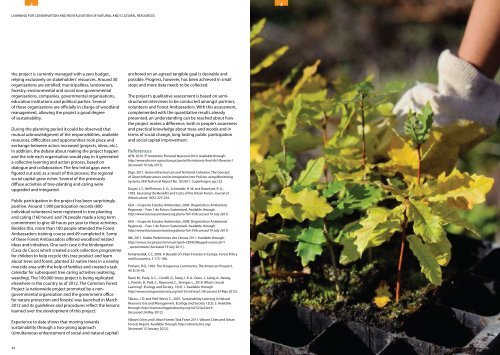TradiTional Knowledge and BiodiversiTy - UNU-IAS - United ...
TradiTional Knowledge and BiodiversiTy - UNU-IAS - United ...
TradiTional Knowledge and BiodiversiTy - UNU-IAS - United ...
You also want an ePaper? Increase the reach of your titles
YUMPU automatically turns print PDFs into web optimized ePapers that Google loves.
2 2<br />
Learning for Conservation <strong>and</strong> Revitalisation of Natural <strong>and</strong> Cultural Resources<br />
the project is currently managed with a zero budget,<br />
relying exclusively on stakeholders’ resources. Around 30<br />
organisations are enrolled: municipalities, l<strong>and</strong>owners,<br />
forestry, environmental <strong>and</strong> social non-governmental<br />
organisations, companies, governmental organisations,<br />
education institutions <strong>and</strong> political parties. Several<br />
of these organisations are officially in charge of woodl<strong>and</strong><br />
management, allowing the project a good degree<br />
of sustainability.<br />
During the planning period it could be observed that<br />
mutual acknowledgment of the responsibilities, available<br />
resources, difficulties <strong>and</strong> opportunities took place <strong>and</strong><br />
exchange between actors increased (projects, ideas, etc.).<br />
In addition, the debate about making the project happen<br />
<strong>and</strong> the role each organisation would play in it generated<br />
a collective learning <strong>and</strong> action process, based on<br />
dialogue <strong>and</strong> collaboration. The few initial gaps were<br />
figured out <strong>and</strong>, as a result of this process, the regional<br />
social capital grew richer. Several of the previously<br />
diffuse activities of tree-planting <strong>and</strong> caring were<br />
upgraded <strong>and</strong> integrated.<br />
Public participation in the project has been surprisingly<br />
positive. Around 1,900 participation records (800<br />
individual volunteers) were registered in tree planting<br />
<strong>and</strong> caring (160 hours) <strong>and</strong> 76 people made a long term<br />
commitment to give 40 hours per year to these activities.<br />
Besides this, more than 100 people attended the Forest<br />
Ambassadors training course <strong>and</strong> 49 completed it. Some<br />
of these Forest Ambassadors offered woodl<strong>and</strong> related<br />
ideas <strong>and</strong> initiatives. One such case is the kindergarten<br />
(Casa do Cuco) which created a cork collection programme<br />
for children to help recycle this tree product <strong>and</strong> learn<br />
about trees <strong>and</strong> forest, planted 32 native trees in a nearby<br />
riverside area with the help of families <strong>and</strong> created a task<br />
calendar for subsequent tree caring activities (watering,<br />
weeding). The 100,000 trees project is being replicated<br />
elsewhere in the country as of 2012. The Common Forest<br />
Project (a nationwide project promoted by a nongovernmental<br />
organisation <strong>and</strong> the government office<br />
for nature protection <strong>and</strong> forests) was launched in March<br />
2012 <strong>and</strong> its guidelines <strong>and</strong> procedures reflect the lessons<br />
learned over the development of this project.<br />
Experience to date shows that moving towards<br />
sustainability through a two-prong approach<br />
(simultaneous enhancement of social <strong>and</strong> natural capital)<br />
anchored on an agreed tangible goal is desirable <strong>and</strong><br />
possible. Progress, however, has been achieved in small<br />
steps <strong>and</strong> more data needs to be collected.<br />
The project’s qualitative assessment is based on semistructured<br />
interviews to be conducted amongst partners,<br />
volunteers <strong>and</strong> Forest Ambassadors. With this assessment,<br />
complemented with the quantitative results already<br />
presented, an underst<strong>and</strong>ing can be reached about how<br />
the project makes a difference, both in people’s awareness<br />
<strong>and</strong> practical knowledge about trees <strong>and</strong> woods <strong>and</strong> in<br />
terms of social change, long-lasting public participation<br />
<strong>and</strong> social capital improvement.<br />
References<br />
AFN, 2010. 5º Inventário Florestal Nacional 2010. Available through:<br />
http://www.afn.min-agricultura.pt/portal/ifn/relatorio-final-ifn5-florestat-1<br />
[Accessed 19 July 2011].<br />
Dige, 2011. Green Infrastructure <strong>and</strong> Territorial Cohesion. The Concept<br />
of Green Infrastructure <strong>and</strong> its Integration into Policies using Monitoring<br />
Systems. EEA Technical Report No. 18/2011. Copenhagen. pp.132.<br />
Dwyer, J. F., McPherson, E. G., Schroeder, H. W. <strong>and</strong> Rowntree, R. A.,<br />
1992. Assessing the Benefits <strong>and</strong> Costs of the Urban Forest. Journal of<br />
Arboriculture 18(5): 227-234.<br />
GEA – Grupo de Estudos Ambientais, 2006. Diagnósticos Ambientais<br />
Regionais – Fase 1 do Futuro Sustentável. Available through:<br />
http://www.futurosustentavel.org/plano/?id=9 [Accessed 19 July 2011]<br />
GEA – Grupo de Estudos Ambientais, 2008. Diagnósticos Ambientais<br />
Regionais – Fase 1 do Futuro Sustentável. Available through:<br />
http://www.futurosustentavel.org/plano/?id=9 [Accessed 19 July 2011]<br />
INE, 2011. Dados Preliminares dos Censos 2011. Available through:<br />
http://censos.ine.pt/xportal/xmain?xpid=CENSOS&xpgid=censos2011<br />
_apresentacao [Accessed 19 July 2011].<br />
Konijnendijk, C.C, 2003. A Decade of Urban Forestry in Europe. Forest Policy<br />
<strong>and</strong> Economics, 5 173–186.<br />
Putnam, R.D., 1993. The Prosperous Community. The American Prospect,<br />
4(13):35-42.<br />
Reed, M., Evely, A. C., Cundill, G., Fazey, I. R. A., Glass, J., Laing, A., Newig,<br />
J., Parrish, B., Prell, C., Raymond, C., Stringer, L., 2010. What is Social<br />
Learning?. Ecology <strong>and</strong> Society, 15(4): 1. Available through:<br />
http://www.ecology<strong>and</strong>society.org/vol15/iss4/resp1/ [Accessed 24 May 2012].<br />
Tàbara, J. D. <strong>and</strong> Pahl-Wostl, C., 2007. Sustainability Learning in Natural<br />
Resource Use <strong>and</strong> Management. Ecology <strong>and</strong> Society 12(2): 3. Available<br />
through: http://www.ecology<strong>and</strong>society.org/vol12/iss2/art3/<br />
[Accessed 24 May 2012].<br />
Vibrant Cities <strong>and</strong> Urban Forests Task Force 2011. Vibrant Cities <strong>and</strong> Urban<br />
Forests Report. Available through: http://vibrantcities.org/<br />
[Accessed 12 January 2012].<br />
34<br />
35

















